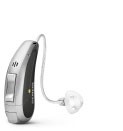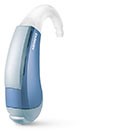
AGIS SAS offers manufacturers or network of hearing professionals a cost-effective integrated program that covers the hearing aid for all risks for additional periods of up to 5 years.
A warranty is the obligation of the manufacturer to maintain your hearing aid in good operating condition and to repair any defect or fault during a given period.
Insurance cover is a commitment of the Insurer, it may be issued by the manufacturer at no additional cost. It may also be offered or sold the by audiologist.
Your hearing aids come automatically with a manufacturer’s warranty with the purchase or when getting them. However, there are not covered for all risks.
The manufacturer’s warranty usually includes an initial 2 years cover for faulty circuit or any adjustment issue of the ear mould.
When the initial guarantee expires, AGIS SAS additional cover offered by the manufacturer or by the audiologist will take over the cover to ensure the device works properly, REGARDLESS OF THE CAUSE OF THE DAMAGE – this is an All Risks Cover.
There for covering your needs.
AGIS SAS has already insured with manufacturers, over 300,000 top brand hearing aids.
There are different models of hearing aids to meet the needs and expectations of each user profile.
They all have common features. They were designed to amplify sounds you want to hear, make low sounds audible, while reducing loud sounds, for more sharpness in noisy or quiet environments. No hearing aid can completely restore the hearing, they bring the amplification needed for a better hearing and understanding.
A hearing aid is a miniature sound amplification system. All devices house the following components:
• A microphone
• An amplifier (usually with digital processing)
• A miniature speaker called receiver
• Either a moulded in-ear shell (tailor-made base on the shape of the ear canal) or a box (BTE)
• A battery or an accumulator
There are different models of hearing aids to meet the needs and expectations of each user profile.
They all have common features. They were designed to amplify sounds you want to hear, make low sounds audible, while reducing loud sounds, for more sharpness in noisy or quiet environments. No hearing aid can completely restore the hearing, they bring the amplification needed for a better hearing and understanding.
A hearing aid is a miniature sound amplification system. All devices house the following components:
• A microphone
• An amplifier (usually with digital processing)
• A miniature speaker called receiver
• Either a moulded in-ear shell (tailor-made base on the shape of the ear canal) or a box (BTE)
• A battery or an accumulator
There are different types of hearing aids, of different shapes and different colours. Each hearing aid is chosen, adjusted based on the individual hearing needs.
The easiest way to classify the hearing aids is to categorise them based on their location. There are mainly two kinds of devices:
- RIC is the receiver-in-canal abbreviation in English. The other word for RIC’s is BTE.[???]
- BTE is the abbreviation of behind-the-ear in English.
- ITE is the in-the-ear abbreviation in English. The other word for ITE is in-ear hearing aid.
BTEs with earpiece in the canal (RIC):
RICs are similar to OPEN devices. However, the earpiece connected to the device through a thin tube is in the ear canal. No longer housed in the case, the size of the device has been greatly reduced. The RIC is a small, lightweight and virtually invisible BTE microphone.
BTE – Behind The Ear
They are placed behind the ear. They cover any hearing loss, from mild to profound loss. They may be fitted with directional microphones to improve speech understanding in the noisiest situations.
BTEs may be open or closed. “Closed” means they are connected to the ear canal via an ear-mould customised to the ear of the patient. They provide full power and are easy to operate. The ear-mould is customised, based on the patient’s ear shape. The ear mould must be perfectly adjusted for its amplification and understanding to be fully operational. Through the tube, the ear mould should conduct the sound through the ear canal. It also improves the position and the support of the device on the ear. An essential aspect of the ear mould is to close the ear canal to avoid the feedback (Larsen).
Into the Ear (ITE):
There are different shapes of ITEs placed entirely into the ear They are custom-made from the ear canal mould of the user There are different models ranging from the smallest micro-CIC, an hearing aid to be placed entirely ‘in the ear’, to the half shell, a bigger device.

RICs are similar to OPEN devices. However, the earpiece connected to the device through a thin tube is in the ear canal. No longer housed in the case, the size of the device has been greatly reduced. The RIC is a small, lightweight and virtually invisible BTE microphone.
They are placed behind the ear. They cover any hearing loss, from mild to profound loss. They may be fitted with directional microphones to improve speech understanding in the noisiest situations. BTEs may be open or closed. “Closed” means they are connected to the ear canal via an ear-mould customised to the ear of the patient. They provide full power and are easy to operate. The ear-mould is tailor-made, based on the patient’s ear shape. The ear mould must be perfectly adjusted for its amplification and understanding to be fully operational. Through the tube, the ear mould should conduct the sound through the ear canal. It also improves the position and the support of the device on the ear. An essential aspect of the ear mould is to close the ear canal to avoid the feedback (Larsen).


There are different shapes of ITEs placed entirely into the ear They are custom-made from the ear canal mould of the user There are different models ranging from the smallest micro-CIC, an hearing aid to be placed entirely ‘in the ear’, to the half shell, a bigger device.
- Always place them in a safe place, such as the hard case that came with your hearing aids.
- Always store them in the same place if possible.
- Avoid unnecessarily removing your hearing aids during the day.
- Wearing a hearing aid helps permanently prevent this kind of risk
- Never place your hearing aids in a tissue, because it always ends up in the rubbish bin.
- Keep a travel pouch in your bag or anywhere else.
- For children or for people with loss of autonomy, use a clip to keep the hearing aid attached to your clothes.
- If you remove your hearing aid, and if you have a dog, always switch it off since the vibrations from this device, that you can’t hear, are absolutely unbearable to the dog’s ear; he will jump on the hearing aid to stop that noise that makes him crazy.






